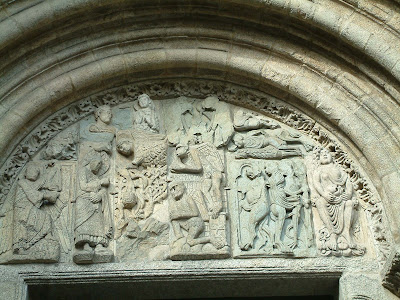The city is familiar to us as we listen to the chatter in the square, admire its monuments, and wend our way through its streets.

The skies that held back their tears as we made our way through Galicia now open up and cry with abandon. Wind gusts tug at umbrellas. In the plaza in front of our hotel we encounter Gillian who arrived two days earlier; this evening her husband will join her if the weather allows his plane to land. The cathedral becomes the focus of our attention and the target of repeated visits to its vast interiors and its museum.
 Tapestry Based on a Cartoon by Goya
Tapestry Based on a Cartoon by GoyaWe are in the cathedral for noon mass on Saturday, when we are lucky enough to see the giant botafumeiro, the incense burner, in action.
That evening a repeat performance by this enormous dispenser and its team of eight handlers will be in store for us. (To witness click the small arrow in the lower left corner of the picture.)
Botafumeiro in Action
That afternoon we present at the church office our pilgrim's passports containing the stamped symbols of churches, hostals, restaurants and bars from all across the north of Spain, several from every day of our Camino. This testimony to our pilgrimage leads to the issue of our Compostela, the document in Latin that attests to our having completed the Camino. At the Sunday mass when the list of pilgrims by country will be read out, the four of us will make up the majority of the six Canadians reported as having completed the Camino.
Our hotel, the Hostal de los Reyes Catolicos, a place where pilgrims have found repose ever since the middle ages, attends to us when we want rest. Its dining room elevates our physical condition to an exalted level.
Yet our mood is not in the ascendant. It is anti-climactic. Why?
Afterwards I wondered about this gap between what I expected to feel, and what I did feel. Why were we not as excited as we should have been during those first days in Santiago? We had completed the Camino. Certainly the city offered the visitor treasures beyond the cathedral itself.

Monastery of Saint Martin Pinario

Altar, Saint Martin Pinario

Banquet Hall, Palace of Archbishop Gelmírez
We had arrived in a city with many treasures. Right in front of our eyes was an important foundation block for the Christian faith?

Saint James Standing Guard at the Cathedral
Could it be the weather, which had turned miserable?
Could it be that one can experience the thrill of the Camino only once in one's lifetime? But Encarnita felt the same way as I did and this was her first Camino.
Certainly our entry into the cathedral was disappointing. The Puerta de la Gloria, one of Europe's most important medieval heritages, was dismantled and under restoration. Nor could we reach out and touch that entrance pillar, grasped by pilgrims completing the Camino. By so many and for so long that indentations had been worn into the marble. Restoration efforts had put it out of bounds. In the scale of Santiago time, all would soon be back in place, but for us it was out of reach.

Figures on the Puerta de la Gloria (photographed on a previous visit)
Even so, the cathedral constantly absorbed our attention. The south door leading onto the Plaza de las Platerías, was still there with its familiar faces.
I believe the answer to this puzzle is to be found in the message left by so many pilgrims:
The Camino is not the goal, the Camino is the journey.
The memories we carry with us are memories of the days on the paths, of the people we met, and the sense of history at our side. Santiago de Compostela, the city is important and we would again enjoy its beauty. It was the Camino, however, that would remain strong in our minds.






















































